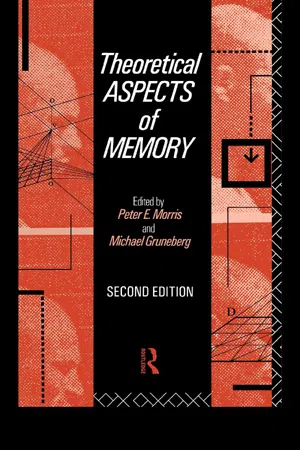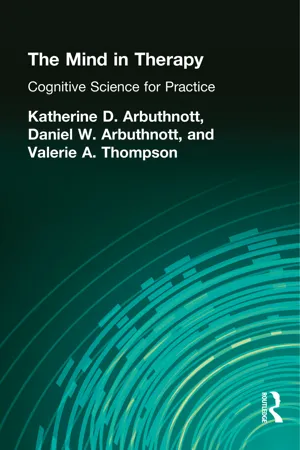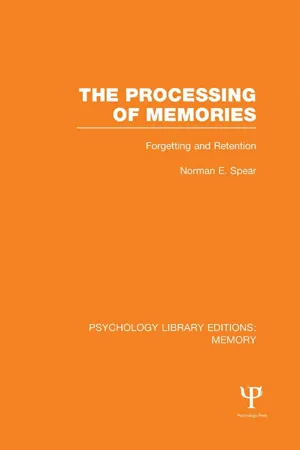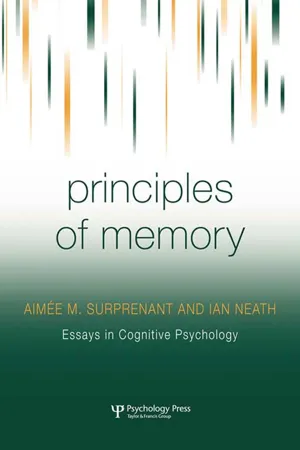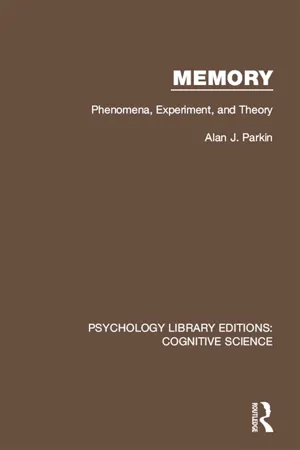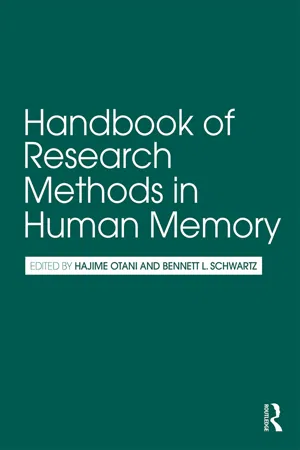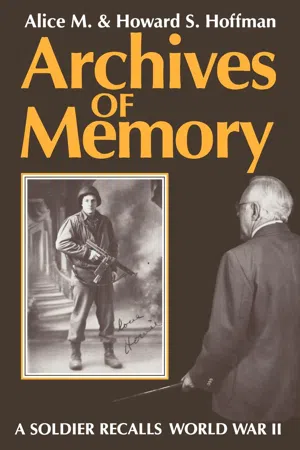Psychology
Cue-Dependent Forgetting
Cue-dependent forgetting is a phenomenon in memory where the ability to recall information is influenced by the presence or absence of specific cues or prompts. When the retrieval cues present during learning are not available during recall, it can lead to difficulty in remembering the information. This concept highlights the importance of environmental and contextual cues in memory retrieval.
Written by Perlego with AI-assistance
Related key terms
Related key terms
1 of 4
Related key terms
1 of 3
12 Key excerpts on "Cue-Dependent Forgetting"
- eBook - ePub
Theoretical Aspects of Memory
Volume 2
- Michael Gruneberg, Peter E Morris, Michael Gruneberg, Peter E Morris(Authors)
- 2006(Publication Date)
- Routledge(Publisher)
Mood-dependent memory must be distinguished from mood- congruent memory (e.g. Blaney 1987). Mood congruence is the finding that emotionally laden stimuli are learned and remembered best when their affective valence matches the subject’s mood. For example, in a depressed mood, a subject might learn and remember negatively valenced words, such as ‘funeral’ or ‘sorrow’, better than positively valenced words, such as ‘funny’ or ‘carnival’. Although mood congruent effects resemble mooddependent memory effects, they are not the same. Mooddependence is a principle that relates study and test moods to each other, whereas mood congruence describes a relation between subjective moods and target stimuli.THEORETICAL PRINCIPLES
The principles to be considered here will include cuedependence, overshadowing, contextual fluctuation, cue overload, memory probe, outshining and decontextualization.A number of basic principles can be induced from the empirical studies reviewed above. Although these principles are intended to explain contextual dependence, they do not necessarily imply specific theoretical mechanisms. Principles such as cue overload, outshining or decontextualization can be implemented with different theoretical mechanisms in different theories. Any memory theory, however, that involves context-dependent memory should incorporate these basic principles.Cue-dependent memory
The principle of cue-dependent memory is simply that performance on memory tasks is influenced by associated memory cues. If contextual information is associated with target material, then contextual cues should stimulate memory for associated material.There are many theoretical mechanisms that can explain context-dependent memory, and a few will be described here. These include activation of a set of information in memory, direct context-to-item associations, mediation by internal states, and activation of cognitive operations.Activation of a search set
Shiffrin (1970) described retrieval as a probabilistic iterative process involving sampling-with-replacement from a delimited set of information in memory. The delimited set was referred to as a ‘search set’, or the set of information in memory that was to be deliberately searched. By keeping memory searches within this set, one’s retrieval efforts could be more efficient than if all of memory were searched. - eBook - ePub
The Mind in Therapy
Cognitive Science for Practice
- Katherine D. Arbuthnott, Dennis W. Arbuthnott, Valerie A. Thompson(Authors)
- 2014(Publication Date)
- Routledge(Publisher)
Activation of memories by environmental cues can also influence behavior, as goals are also stored in memory and situational cues can activate relevant goals, within or outside of awareness (Fitzsimons & Bargh, 2004). For example, social goals such as achievement or cooperation can be primed by cues such as particular locations (such as a library; Aarts & Dijksterhuis, 2003) that influence our behavior in goal-relevant ways, even when we are not aware of the activation of the goal.In therapy, many clients (and often therapists) assume that if a client recalls a particular memory vividly and frequently, it is because that memory is centrally important. However, it may just be that the memory is simply being cued more frequently. For example, a client who often remembered past slights assumed these were strong memories that needed attention rather than that she was cued to these memories by current slights, such as feeling ignored by waiters or store clerks, having family members be late for commitments to her, and the like. The potential confusion here is that the therapist or client could assume there is unfinished business from the past rather than a current pattern to shift. Of course, a skilled therapist could address this issue either by addressing the past or the present, but it is important for therapists to be aware of the nature of priming so they can assist clients to manage their issues in the most efficient manner.The Cue-Dependent Nature of Memory Retrieval
The previously mentioned mnemonic strategies of associating to-be-learned material with well-known or easily recalled information highlights the most important element of this associative model: the cue-dependent nature of memory retrieval. To recall any item from memory, we must first cue the search for that item. This is why hints, which cue the network near the desired memory, are so helpful in memory retrieval (Reisberg, 1997). For example, asking a client about her relationship with family members can cue memories of family events, such as dinner conversations or holiday gatherings. As any student knows, a good method to develop ideas for an essay is to read other authors’ thoughts on the subject, priming the student’s own related knowledge. The stronger the association between the cue and the target memory (the event or information you are trying to remember), the easier the retrieval search is. Thus, it is not the strength of a memory itself that determines its recall, but rather the strength of the connection between the memory and whatever cue is currently available. Advertisers attempt to use this aspect of memory to their advantage by displaying their advertisements frequently in an attempt to strengthen the associations between their product and a desired state (e.g., happiness, satisfaction). Important personal memories are strongly associated with many different types of cues, which is why they are often easily recalled. However, even for those memories, if we were prompted with a poor cue, retrieval would be difficult. - eBook - ePub
- Ronald T. Kellogg(Author)
- 2015(Publication Date)
- SAGE Publications, Inc(Publisher)
TOT states suggest that information may be available in memory but inaccessible. The forgetting seems to be clearly caused by a failure to find the right retrieval cue. Sometimes, we can successfully recall the forgotten information by stumbling on a thought or perception that triggers the memory. The principle of encoding specificity explains this as another example of Cue-Dependent Forgetting. Numerous other experiments have documented the principle that the specific cues associated with an event during learning provide the key to later recall (e.g., Begg & White, 1985; Jacoby, 1974).Learning Activity 5.2 A Demonstration of the Tip of the Tongue State
Try to name the capitals of the following states in the United States and countries in the European Union. Is there one (or more) for which you believe you know the answer but cannot retrieve it? Can you guess how many syllables are in the name? Can you guess the initial letter of the name?- State
- Maine
- New Hampshire
- Georgia
- South Dakota
- Arizona
- Tennessee
- Rhode Island
- Iowa
- Virginia
- Oregon
- Country
- Finland
- Belgium
- Denmark
- Italy
- Germany
- United Kingdom
- Luxembourg
- Portugal
- Austria
- Sweden
Environmental Context.
The context in which learning is experienced ought to serve as a retrieval cue at the time of test, according to the encoding specificity principle. This has been tested by varying the environmental and psychological contexts in a large number of experiments. Of interest to students, Smith, Glenberg, and Bjork (1978) had people learn a list of words in a particular room and then later try to recall them in the same room, or in one very different in appearance. The environmental context affected recall in the direction one would expect. The same room provided the right retrieval cues and supported superior performance. Although the effect was not large, it might pay off to study for an exam in the same room in which you will be tested. - eBook - ePub
The Processing of Memories (PLE: Memory)
Forgetting and Retention
- Norman E. Spear(Author)
- 2014(Publication Date)
- Psychology Press(Publisher)
Suppose, for example, a rat is conditioned to jump onto a ledge at the sound of a bell in order to avoid a shock. If the rat is treated with a hypothetical drug that alters the threshold of firing for all neurons controlling auditory memories, it may not retrieve the memory of the original training episode (and hence the target attribute of jumping onto the ledge), regardless of how similar all circumstances are to that episode, because the processing of all memories involving an auditory component has been disrupted. Compare this malfunction of processing with a situation in which appropriate stimuli are insufficient or ineffective. A similar rat in a normal physiological state (i.e., no drug) presented with the same bell and ledge, but in a different laboratory, may retrieve the memory too slowly to avoid the shock, or it may fail totally in retrieving the memory. Here the failure is not in the process but simply because the odors, sounds, and sights of the new laboratory do not correspond sufficiently to the events represented as attributes of the original memory. We may say that the retrieval process probably is intact, but the effectiveness of retrieval is deficient because of insufficient retrieval cues.For our purposes, a contextual cue is any event noticed by an organism, with the specific exclusion of the features that are required to define evidence of memory acquisition (original learning) . In experimental tests of memory, this would exclude, for example, the specific stimulus for a response in a paired-associate task, the specific conditioned stimulus (CS) for classical conditioning, or the discriminative stimulus in instrumental conditioning. Where a discrimination is involved, both the CS+ and CS−, or correct and incorrect stimuli (S+ and S−), would be excluded. Except for the response used as the index of learning, all other events noticed by an organism would be contextual stimuli, including the proprioceptive stimuli that are consequences of the response. Of special importance here is the fact that a contextual cue has latent capacity for retrieval.Contemporary context and prior cueing to influence memory retrieval. - eBook - ePub
Tutorial Essays in Psychology
Volume 2
- N. S. Sutherland(Author)
- 2014(Publication Date)
- Psychology Press(Publisher)
4 Analyzing Memory by Cuing: Intrinsic and Extrinsic KnowledgeGregory V. Jones University of OxfordThis chapter is concerned with the processes which underlie the everyday use of human memory. One of the most striking aspects of memory is the richness of the interconnections between different items of stored information. Until quite recently, however, most experimental studies of human memory have investigated the recall of isolated pieces of information such as sets of unrelated words. It can be argued (Neisser, 1976) that one of the most pressing needs within experimental psychology as a whole is to investigate processes of a degree of complexity comparable to those that occur in everyday life, and several such studies have recently been reported (e.g., Linton, 1975; Robinson, 1976).It must be recognized, however, that in general the price of investigating more complex examples of recall is an increase in the difficulty of maintaining experimental control. For example, in an interesting study, Robinson (1976) presented subjects with cues such as "window," "run," or "happy," and asked each person to think of a specific incident of which the word reminded him or her. One of the findings was that affect terms such as "happy" induced recall of more recent events than did object or activity terms such as "window" or "run." One interpretation might be that memories of such incidents decay particularly rapidly, and thus only comparatively recent emotional experiences are available for recall. It could be, however, that people experience incidents relating to "happy" more frequently than those relating to "window" or "run," and hence come across such incidents earlier when scanning backwards in time. To decide between these two interpretations it would be necessary to undertake an experiment in which the frequency of occurrence of such incidents was controlled. The general problem with the investigation of memory for everyday events is that there is a large range of admissible theoretical interpretations, because we do not have a sufficiently detailed knowledge of the relevant conditions. - eBook - ePub
Current Issues in Cognitive Processes
The Tulane Flowerree Symposia on Cognition
- Chizuko Izawa(Author)
- 2014(Publication Date)
- Psychology Press(Publisher)
As we noted at the outset, context-dependent forgetting is a primitive assumption in many current memory models. This assumption is not often submitted to critical analysis, even though the value of such memory models as explanations of remembering and forgetting is largely predicated on its truth. The literature reviewed here suggests that our reliance on context change as the major factor explaining forgetting needs to be seriously questioned. We have argued that the range of situations under which changing incidental EC will negatively affect performance (i.e., produce forgetting) is limited, owing to the roles of outshining and mental reinstatement. Tying general explanations of forgetting to changes in incidental EC would therefore not appear to be advisable, even if EC cues are encoded and later influence retrieval under some conditions. It might be argued that changes in integral and influential context are primarily responsible for forgetting; however, this argument lacks plausibility. It is clear that large amounts of forgetting occur in situations in which no obvious changes in integral or influential context have occurred. For example, an item on a recognition test, unless highly ambiguous in meaning, is likely to be interpreted semantically in the same way as it was interpreted at study. Yet a subject might still fail to recognize that item. Change in physiological context is another often-invoked candidate in explanations of forgetting. Again, the idea that this type of context is subject to changes within an experimental session that are extreme enough to produce forgetting is simply implausible.Based on the evidence reviewed above concerning the role of contextual variation in reducing interference, it seems that theoretical explanations of forgetting need to focus not on contextual change, but on the interference that occurs between items that are encoded in similar contexts. In other words, we need to develop theories that deal in a systematic manner with the problems of interference that preoccupied researchers in an earlier era. As proposed by those earlier researchers (e.g., Bilodeau & Schlosberg, 1951; McGovern, 1964), contextual factors probably play an important role in modulating interference processes. However, as noted by Bjork (1989), in the brain-metaphor-influenced theoretical environment of the late 1980s, it is perhaps finally appropriate to reintroduce the additional notion of active retrieval inhibition into our explanations of forgetting and remembering.INCIDENTAL EC CUES IN PERSPECTIVE: TOWARD A TAXONOMYWe have restricted our focus here to contexts of a particular type (incidental environmental context) and to effects on memory measured in a particular way (recall). In terms of the possible types of contextual features that might be reinstated, however, and in terms of the possible measures of memory that might show an influence of such reinstatement, that restriction is severe. In this final section, in an attempt to lend some organization to the entire space defined by the various types of contexts and types of measures, we propose a three-dimensional taxonomy. - eBook - ePub
- Aimée M. Surprenant, Ian Neath(Authors)
- 2013(Publication Date)
- Psychology Press(Publisher)
Models of immediate and working memory also use cues and are also cue driven. For example, in the Burgess and Hitch (1999) model, an instantiation of the phonological loop component of working memory (Baddeley, 1986), a slowly varying context-time signal is used to initiate the retrieval process. This type of cue is also used by OSCAR (Brown, Preece, & Hulme, 2000), a very different model that addresses many aspects of immediate serial recall. Yet another account of similar data is offered by the feature model (Nairne, 1990), which also requires cues. Connectionist models of memory are also cue driven (cf. Ratcliff, 1992). Humphreys, Bain, and Pike (1989) present a model that specifies the cues used not only in episodic and semantic tasks, but also those that tap procedural memory. In fact, it is hard to conceive of a computer model of memory that is not cue dependent, simply because the computer requires something to start the retrieval process.3.2 Memory Without Cues
There is one area of memory research in which the opposite assumption is made, that is, memory does not require cues. For example, Kintsch, Healy, Hegarty, Pennington, and Salthouse (1999) summarized 10 different theoretical accounts of working memory, highlighting similarities and differences among the various conceptions. They explicitly noted that because of the common assumption that “information ‘in’ working memory is directly and effortlessly retrievable, … retrieval from ST-WM is not cue dependent” (pp. 413–414).2 Similarly, Wickens, Moody, and Dow (1981, p. 17) state that “the retrieval act is not required in the PM [primary memory] situation.” More recently, Jonides et al. (2008, p. 202) note that “the central point of agreement” among current models of short-term memory is that “representations are directly accessible and available for cognitive action.”One particular version of working memory that posits cueless retrieval is called the embedded processes model (Cowan, 1995, Cowan, 1999). Essentially, memory is divided into three parts (see Figure 3.1 ): Long-term store, activated memory, and the focus of attention. Together, the activated part of long-term memory as well as the contents in the focus of attention comprise working memory.According to this view, an item becomes activated when it receives attention, and activated items can enter the focus of attention when they are the object of current processing. Thus, in terms of a typical memory experiment, retrieval means “entering the correct items into the focus of attention” (Cowan, 1999, p. 75). If an item is in the focus of attention, it does not have to be retrieved. The focus of attention is limited to approximately four unrelated items (Cowan, 2000); in addition to this item-based limit, - eBook - ePub
Memory
Phenomena, Experiment and Theory
- Alan Parkin(Author)
- 2016(Publication Date)
- Routledge(Publisher)
Generation-recognition theory proposes that retrieval involves two stages. Recall also involves these two stages, but recognition proceeds without generation. Experiments on encoding specificity suggest, by contrast, that recall and recognition reflect a common retrieval process. The debate as to which of these theories is correct continues. Experiments on recognition memory indicate that two independent processes can contribute to recognition: context retrieval and familiarity. Context retrieval is dependent on explicit recollection, whereas the processes underlying familiarity-based responding bear a considerable similarity to those responsible for implicit memory phenomena. Context-retrieval and familiarity-based recognition are associated with different experiential awareness.Context Effects
Regardless of which particular model of retrieval eventually proves correct, it is clear that context plays an important role in our everyday memories. I remember watching a travel programme on TV in which the director focused on what he thought was a typical inhabitant of the Loire Valley, who was, in fact, one of my departmental colleagues. Given this unlikely context, it took me about 30 seconds to carry out a recognition response that would normally occur almost instantly.There are many formal demonstrations that context exerts powerful effects on our ability to identify things. In a classic experiment, Light and Carter-Sobell (1970) demonstrated how changes in the intrinsic context associated with a target could reduce recognition memory. Subjects studied simple sentences which biased subjects towards encoding one particular meaning of an ambiguous word (e.g. They were stuck in a traffic jam’). Retention testing involved subjects identifying the target words, which were again embedded in biasing sentences but, in half these, the sentence was biased toward a different meaning from that used at encoding (e.g. ‘They enjoyed eating the jam’). It was found that recognition of the targets was significantly reduced when the biasing context at test was different from that at learning.Disruptive effects of changing intrinsic context between learning and test are perhaps not surprising, because, in effect, what is being shown is that subjects are worse at remembering a different stimulus from the one they studied. More interesting, and potentially more relevant, is the possibility that extrinsic context could exert effects on remembering. - eBook - ePub
- Hajime Otani, Bennett L. Schwartz, Hajime Otani, Bennett L. Schwartz(Authors)
- 2018(Publication Date)
- Routledge(Publisher)
Along these same lines, whereas earlier research on free recall tended to focus on semantic clustering, later research has focused on temporal contiguity. For example, Kahana (1996) presented a method of studying associative processes at retrieval during free recall tasks. He used conditional response probabilities in the recall order among items produced by each participant to show that there was a relationship between the order produced by the participant during recall and their relative positioning in the study list—an effect that has come to be known as the temporal contiguity effect. Basically, when people recall one item, it is thought to serve as a reminder or cue for another item, which in turn, serves as a reminder or a cue for yet another item, and so on. Indeed, a meta-analysis of free recall studies suggests that recalling one item leads to retrieval of mental states previously associated with that item; these previous mental states are thought to blend with the immediate context to cue the next item to be retrieved in a process called compound cuing (Lohnas & Kahana, 2014).Finally, another more recent development in free recall measures concerns the study of recall termination (Miller, Weidemann, & Kahana, 2012). Miller et al. analyzed the termination probability across 14 existing free recall studies plus a newly carried out experiment of their own and found that the probability of recall termination increased as more time passed across the span of the recall phase and was more probable after an incorrect than a correct recall response. They also found that the type of error mattered: Participants were more likely to terminate their recall attempts after intrusions from prior lists or after generating items that had already been recalled than after extra-experimental intrusions.Cued Recall
Cues Aid Memory Retrieval
Another way to elicit recall in a list-learning paradigm is to provide participants with cues to use in generating their responses at the time of test. Generally, providing cues at test leads to a greater likelihood of successful recall than providing no cues (e.g., Tulving & Pearlstone, 1966; Wood, 1967). Given the same study conditions across participants, participants who are given cues, such as category names at test (e.g., fruits) for items that had appeared at study (e.g., apple, banana, pear), tend to recall a higher proportion of items from the study list than participants asked to engage in free recall. In short, cues help in accessing information from memory. This principle has been apparent from numerous studies of encoding specificity and context reinstatement as well (e.g., Godden & Baddeley, 1975). - eBook - ePub
- Laird Cermak(Author)
- 2014(Publication Date)
- Psychology Press(Publisher)
Fig. 8.9 ). Here, they performed significantly better than the amnesic groups in the standard/standard and standard/contextual conditions, but not as well as the amnesic group in the contextual/contextual condition. This pattern clearly suggests a defect in encoding mechanisms, but one that can be at least partially compensated for by salient contextual cues. However, the added cues at original learning alone did not provide for maximal performance at retrieval. Instead, the presence of the cues at retesting was necessary to aid the amnesics in gaining access to the desired information during retrieval. Thus, both encoding and retrieval processes are implicated, lending further weight to the argument (see Cermak, this volume) that the amnesic syndrome represents a general dysfunction of information processing.FIG. 8.9. Percent retention by amnesic and control groups as a function of differential cuing at learning and recall.Although, in our experiments, amnesics consistently benefited from contextual cuing and controls did not, it would be premature to postulate the existence of a qualitative defect differentiating amnesics from normal individuals. In all our studies simple tasks designed to fall within the learning capabilities of amnesic patients were used. As a result, performance of the controls was consistently at or near ceiling levels. Available evidence does suggest that normal subjects use contextual cues for encoding or retrieval purposes when the tasks are difficult or involve highly ambiguous cues (Keppel, 1972, pp. 83–109). In our experiments, these conditions could be said to apply only to the amnesic patients, not to the normals. Increasing the complexity of these tasks might very well lead to similar results in normals.One study that does relate to this possibility has been performed by Squire, Nadel, and Slater (1981) who presented amnesics and controls with successive lists of sentences and then, at varying retention levels, tested their ability to recognize each sentence and to identify the list in which it appeared. The first they defined as a test of episodic memory, the second as one of temporal contextual judgement. Their consistent finding was that a correlation existed between the two tests. That is to say, at long intervals when recognition performance by controls had fallen off to amnesic levels (at shorter intervals), the groups did not differ in terms of their contextual judgement abilities. Thus, a decline in the ability to utilize contextual information appears to be another feature of the forgetting process that characterizes both amnesic and normal retention. The fact that, in our experiments, amnesics responded to salient cues whereas controls did not probably reflects the amnesics’ basic difficulty with the tasks and the normal’s ease in handling the tasks. - eBook - ePub
- Graham M. Davies, Daniel B. Wright(Authors)
- 2009(Publication Date)
- Psychology Press(Publisher)
Thus, the notion of destructive updating where memory is kept up to date by overwriting older or out-of-date information with new (cf. Loftus, Miller, & Burns, 1978) seems a potentially costly enterprise – not only in terms of the social gaffes we are likely to make (e.g., phoning up our old flames by mistake) but also in terms of the cognitive effort and time that would be needed to relearn material (e.g., the telephone number of one’s current partner). Rather, it would seem that there is a need for memory updating to be achieved in a much more subtle and flexible manner – one in which memories that are deemed irrelevant for a current task can be excised from conscious inspection but not irrevocably lost (E. L. Bjork, Bjork, & MacLeod, 2006; M. D. MacLeod & Macrae, 2001). Thus, related but unwanted memories can be temporarily forgotten for as long as it takes to complete the current task but subsequently become available for some future task should they be required. We believe that the mechanism underlying retrieval-induced forgetting (i.e., inhibition) may offer just this kind of flexibility in memory updating.Retrieval practice and memory performanceRetrieval-induced forgetting refers to a particular pattern of forgetting that occurs as a result of the selective retrieval practice of other related material. Unlike directed forgetting (e.g., Johnson, 1994; C. MacLeod, 1989), this specific form of forgetting occurs implicitly as a result of the retrieval process itself (i.e., there are no explicit instructions to forget material). Rather, forgetting occurs as a function of the retrieval competition emanating from related memories. In order to deal with unwanted competition at retrieval, related memories are actively inhibited or suppressed, thereby promoting the retrieval of the material we wish to remember.The standard procedure used to explore retrieval-induced forgetting typically comprises a four-phase retrieval practice paradigm (M. C. Anderson et al., 1994). Although there are a number of variations, the basic paradigm generally involves the presentation of a series of category–exemplar pairs (e.g., sport–football, sport–tennis, sport–rugby, sport–cricket . . . tree– sycamore, tree–oak, tree–spruce, tree–poplar . . . bird–sparrow, bird–eagle, bird–robin, bird–mallard . . . vegetable–carrot, vegetable–onion, vegetable– celery, vegetable–broccoli . . .). On completion, participants are cued to retrieve half of the exemplars from half of the categories. For example, participants might be required to complete the following cued stem tests (e.g., sport–fo____, sport–te____; bird–sp____, bird–ea____) but are not prompted to retrieve exemplars from the remaining categories (i.e., exemplars from tree or vegetable categories). Following a distractor task (between 5 and 20 minutes), participants are asked to recall all the exemplars that had originally been presented. - eBook - ePub
Archives of Memory
A Soldier Recalls World War II
- Alice M. Hoffman, Howard S. Hoffman(Authors)
- 2021(Publication Date)
- The University Press of Kentucky(Publisher)
14 They distinguished between intrinsic context and extrinsic context. They defined intrinsic context as those aspects of a stimulus which are inevitably processed when the stimulus is perceived, such as the voice in which an item is spoken or the typeface of a word on the page. Extrinsic contexts are irrelevant to the perceived item, such as the color of the walls in the room. They found that recall is enhanced by both intrinsic and extrinsic contexts but that recognition is enhanced only by intrinsic contexts. In other words, if you know that you will be given a multiple choice or true/false test, it would not enhance your performance to study in the room where you will take the test, but if you are to take an essay-type exam, then studying in the room where you will take the test may be advantageous.Much of psychoanalysis is based on the assumption that all memory is retained somewhere in the recesses of the mind and that by application of categorical or contextual cues (that is, pieces of information or word associations), the patient can be led to retrieve memory that has been suppressed and has hence been unavailable for recall.Sigmund Freud suggested that forgetting is due, in large part, to the repression of events which, if brought to the conscious mind, would cause anxiety or fear. Efforts to find evidence of repression in laboratory experiments on memory processes have, on the whole, not been successful. One study that seems to provide evidence for repression was cited by I.M.L. Hunter. In the study, subjects were asked to produce all the memories which they could recall of their first eight years of life, and then to rate them as unpleasant, pleasant, or neutral. On the average they reported about 50 percent pleasant, about 30 percent unpleasant, and 20 percent neutral.15
Index pages curate the most relevant extracts from our library of academic textbooks. They’ve been created using an in-house natural language model (NLM), each adding context and meaning to key research topics.
Explore more topic indexes
Explore more topic indexes
1 of 6
Explore more topic indexes
1 of 4
